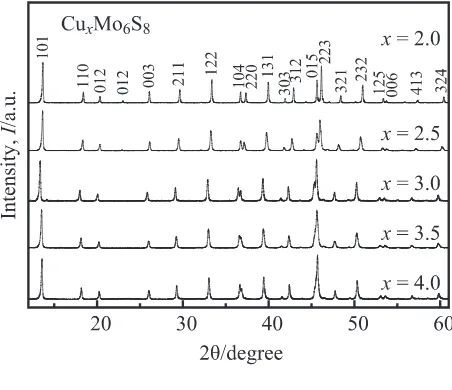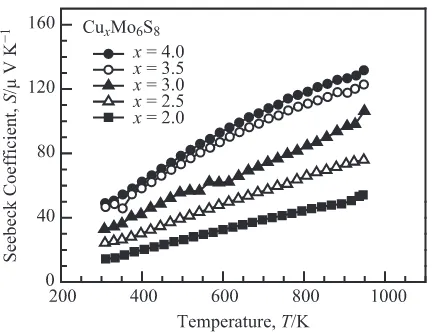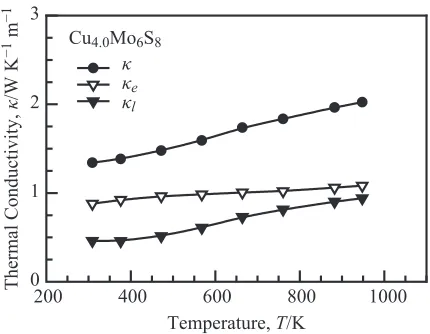Preparation and Thermoelectric Properties
of Chevrel-Phase Cu
xMo
6S
8(
2
:
0
x
4
:
0
)
Michihiro Ohta, Haruhiko Obara and Atsushi Yamamoto
Energy Technology Research Institute, National Institute of Advanced Industrial Science and Technology (AIST), Tsukuba 305-8568, Japan
Chevrel-phase sulfides CuxMo6S8, where2:0x4:0, were prepared by reacting appropriate amounts of Cu, Mo, and MoS2powders at
1273–1523 K for 8 h in vacuum. The samples were then densified by pressure-assisted sintering at 1223–1473 K for 1 h at a pressure of 30 MPa in vacuum. The density of all the sintered samples was greater than 95% of the theoretical density. X-ray analysis showed that all the sintered samples consisted entirely of the hexagonal Chevrel phase. The value of the lattice parameters aandc increased with the Cu content. Measurement of the Seebeck coefficient, electrical resistivity, and thermal conductivity was carried out on single-phase sintered CuxMo6S8
samples in the temperature range of 300–950 K. All the sintered samples had a positive Seebeck coefficient. Further, the thermoelectric properties improved when the Cu content was increased. With an increase in the Cu content, the Seebeck coefficient and electrical resistivity increased, while the thermal conductivity decreased. The highest dimensionless thermoelectric figure of merit ZT (0.4) was observed in Cu4:0Mo6S8at 950 K. [doi:10.2320/matertrans.MAW200918]
(Received April 23, 2009; Accepted June 1, 2009; Published July 15, 2009)
Keywords: thermoelectric materials, Chevrel phase, pressure-assisted sintering, Seebeck coefficient, electrical resistivity, thermal conductivity, thermoelectric figure of merit
1. Introduction
Thermoelectric devices can directly convert waste heat into electrical energy, and hence, they are expected to play an important role in establishing a sustainable society. For efficient conversion of waste heat to electrical energy, it is important to develop thermoelectric materials with high conversion efficiency. The efficiency of a thermoelectric material is determined by its thermoelectric figure of merit
(ZT), which is a dimensionless parameter. ZT is given by
S2T=, where S, T, , and are the Seebeck coefficient,
temperature, electrical resistivity, and thermal conductivity, respectively. For the metals or degenerate semiconductors, the magnitude of Seebeck coefficient is inversely propor-tional to the carrier concentration, and proporpropor-tional to temperature, and effective mass of the carrier. The electrical resistivity is related to carrier concentration thorough
1=¼ne, wheren,e, andare the carrier concentration,
charge of an electron, and carrier mobility, respectively. The thermal conductivity is the sum of the electronic
contribution e and the lattice contribution l, i.e., ¼
eþl. Moreover, the electronic contribution is directly
related to the electrical resistivity through the
Wiedemann-Franz law, e¼LT=, where L is the Lorenz number
(2:45108WK2).
Ternary molybdenum chalcogenides with the general
formula MxMo6X8 (M = Li, Ti, Cr, Fe, Ni, Cu, Zn, Cd,
Sn, Pd, rare-earth metals, etc.; X = S, Se, Te) were first
synthesized by Chevrel et al.,1) and therefore, they are
referred to as Chevrel phases. Several reviews on the crystal structure and superconductivity of Chevrel phases have been
published.2,3)The host structure of a Chevrel phase consists
of a stacking of Mo6X8clusters. The M atoms fill the space
between the Mo6X8 clusters. While large M atoms such as
Pb result in the formation of stoichiometric compounds, small M atoms such as Cu afford nonstoichiometric
com-pounds. For example, it is well-known that the Cu content in
CuxMo6S8, which has a hexagonal (rhombohedral) structure
(space group:R33), is in the range of1:0x4:0.4–9)
Recently, Chevrel phases have attracted considerable
attention since they are potential high-ZT thermoelectric
materials.10–26) Most of the previous studies on Chevrel
phases have focused on Chevrel-phase selenides. Band structure calculations have been carried out for several Chevrel-phase selenides for predicting their thermoelectric
properties.11,13,14,17,24) The results suggest that CrMo
6Se8,
FeMo6Se8, NiMo6Se8, Cu2Mo6Se8, and SnMo6Se8 exhibit
metallic behavior, while TiMo6Se8, Zn2Mo6Se8, and
Cd2Mo6Se8behave like semiconductors.11,13,14,17)Moreover,
the results imply that the Fermi level of TiMo6Se8yshifts to
the valence band edge when the Se content decreases.24)
Therefore, the thermoelectric properties of Chevrel phases would be improved by altering their chemical compositions. However, the effect of M content on the thermoelectric
properties of MxMo6Se8 has not yet been investigated in
detail.
Caillatet al.16)measured the Seebeck coefficient, electrical
resistivity, and thermal conductivity of MxMo6Se8(M = Cu,
Fe, Ti) and found that ZT of Cu1:38Fe0:66Mo6Se8 is 0.6 at
1150 K. Since Chevrel-phase chalcogenides have similarity in the electrical and thermal properties, the Cu-filled Chevrel-phase sulfides are also expected to have excellent high-temperature thermoelectric properties.
Tsubota et al.15) have investigated the thermoelectric
properties of Chevrel-phase sulfides MxMo6S8(M = Fe, Ni,
Ag, Zn, Sn, Pb, Cu). However, X-ray analysis shows that all the aforementioned sulfides contain a large amount of
impurity MoS2 phase. The ZT of all the aforementioned
sulfides is less than 0.1. In order to confirm whether Chevrel-phase sulfides can be used as thermoelectric materials, it is necessary to investigate the thermoelectric properties of single-phase samples.
The purpose of this study was to prepare single-phase
CuxMo6S8samples and study the effect of Cu content on their
thermoelectric properties so as to confirm the feasibility of using Chevrel-phase sulfides as thermoelectric materials. The samples were prepared by reacting appropriate amounts of
Cu, Mo, and MoS2powders at 1273–1523 K and subjecting
the resulting product to pressure-assisted sintering. The Seebeck coefficient, electrical resistivity, and thermal con-ductivity of the sintered samples were measured over the temperature range of 300–950 K.
2. Experimental
The preparation method used in this study is almost the
same as that developed by Kondo et al.27)Commercial Cu
powder (purity: 99.99%; particle size: 1mm; Kojundo
Chemical Laboratory Co., Ltd., Japan), Mo powder (purity:
99.9%; particle size: 1.5mm; Kojundo Chemical Laboratory
Co., Ltd., Japan), and MoS2powder (purity: 99.9%; Kojundo
Chemical Laboratory Co., Ltd., Japan) were used as the starting materials. Appropriate amounts of these powders were mixed well and placed in boron nitride crucibles. The crucibles were then inserted in an alumina tube, and the tube
was evacuated to 7:0103Pa. The samples were heated
to 1273–1523 K at a rate of 5 K/min and maintained at this temperature range for 8 h. The samples were then gradually cooled to room temperature.
The samples were consolidated by pressure-assisted sintering for the fabrication of dense compacts. The powders prepared as mentioned above were placed into graphite dies. The dies were set in a pulsed electric current sintering apparatus (SPS-515S, SPS Syntex Inc., Japan). The chamber
of the apparatus was then evacuated to 7:0103Pa.
Sintering was carried out at 1223–1473 K for 1 h at a pressure of 30 MPa. The heating and cooling rates were 10 K/min and 20 K/min, respectively.
The crystal phase in the sintered samples was studied by
powder X-ray diffractometry (XRD) using CuKradiation
(Rint-Ultima+, Rigaku Co., Japan). The density of each sintered sample was measured using the Archimedes method (AUX120-SMK401, Shimadzu Co., Japan). The microstruc-ture of the fracmicrostruc-tured surfaces and the polished and corroded surfaces was observed under a scanning electron microscope (SEM; JSM-6301F, JEOL Ltd., Japan) at 20 kV accelerating voltage.
The Seebeck voltage and electrical resistivity of the sintered samples were measured simultaneously (ZEM-3, ULVAC-RIKO, Inc., Japan). The measurements were carried out under a helium atmosphere to prevent the oxidation. Moreover, the high-accuracy measurements are feasible in high temperature since helium gas has a high thermal conductivity. The samples were cut into plates of 12 mm length, 4 mm width, and 2 mm thickness by using a diamond cutter (IsoMet Low Speed Saw, Buehler Ltd., USA) for the Seebeck voltage and electrical resistivity measurements. The
Seebeck coefficient is given byV=T, whereV andT are
the Seebeck voltage and temperature difference, respectively. Therefore, the Seebeck coefficient was determined from the slope of the plot of Seebeck voltage versus temperature difference. In this study, the temperature difference between
the ends of each plate was varied from 0 to 10 K. A four-probe technique was used to measure the electrical resistiv-ity. Further, the sample disks of 10 mm diameter and 2 mm thickness were fabricated for the thermal conductivity measurements. The thermal conductivity was measured in vacuum using a laser-flash method (TC-7000, ULVAC-RIKO, Inc., Japan); in this method, the thermal conductivity was calculated from the density, heat capacity, and thermal diffusivity.
3. Results and Discussion
Figure 1 shows the XRD patterns of the sintered
CuxMo6S8 samples. These XRD patterns are in good
agree-ment with those previously published,9)thereby showing that
all the prepared samples consist entirely of single-phase
CuxMo6S8. No impurity phases are formed in any of the
samples. The change in the Cu content results in the changes in the atomic positional parameters, and hence the changes in the XRD peak intensities and positions. As shown in Fig. 2,
the value of the hexagonal lattice parameters a and c
increases with the Cu content. The values of a and c also
agree well with those reported.4–9)
The density of all the sintered samples is found to be greater than 95% of the theoretical density. As shown in Fig. 3, SEM examination of the fractured surfaces reveals
Fig. 1 XRD patterns of the sintered CuxMo6S8samples.
[image:2.595.313.539.408.603.2] [image:2.595.319.534.629.768.2]that the samples have a dense structure, which is consistent with the results of density measurements. The fracture surface of Chevrel-phase sulfides has been conventionally
used for the grain size measurement.28,29)From Fig. 3, the
grain size of the sintered samples is estimated to be of the order of micrometers. Similarly, in polished and corroded surfaces, the grain size is estimated to be of the order of micrometers. Since the grain size is much larger than the mean free path of electron and phonon, the grain boundaries have no effect on the thermoelectric properties.
Since the sintered samples consist of single-phase
CuxMo6S8 and have nearly full density, they can be used
for investigating the thermoelectric properties of Chevrel-phase sulfides. The temperature dependence of the Seebeck coefficient and electrical resistivity are shown in Figs. 4 and 5, respectively. All the samples have a positive Seebeck coefficient, indicating that the dominant carriers are holes. Moreover, the Seebeck coefficient and electrical resistivity show metallic temperature dependence, i.e., they increase linearly with temperature. It is worth mentioning that the chemical composition of the samples has a remarkable effect on the Seebeck coefficient and electrical resistivity—an increase in the Cu content results in increases in both the Seebeck coefficient and electrical resistivity. These increases in the Seebeck coefficient and electrical resistivity are mainly
due to a decrease in the carrier concentration. The electrical properties of the Chevrel phase can be explained in terms
of the cluster-valence-electron count (cluster-VEC).2,12)The
cluster-VEC of MxMo6S8 is calculated of as follows: the
number of electrons required to fill the octets of the S atoms is subtracted from the sum of the number of valence electrons of the M and Mo atoms; the resulting value is then divided
by the number of Mo atoms.2)In the case of CuxMo6S8, the
increase in the Cu content results in an increase in the cluster-VEC and a resultant the decrease in the carrier concentration.
As shown in Fig. 6, the thermal conductivity of CuxMo6S8
is relatively low, ranging from 1.3 to 3.9 W K1m1, and
increases with temperature. Since the electrical resistivity increases with the Cu content, the electronic contribution decreases with an increase in the Cu content. On the other hand, the lattice contribution remains essentially unchanged when the Cu content is increased and ranges from 0.9 to
1.1 W K1m1at 950 K.
Figure 7 shows the temperature dependence of the thermal conductivity, electronic contribution, and lattice contribution
for Cu4:0Mo6S8. The electronic contribution is higher than
the lattice contribution over the entire temperature range considered in this study. The lattice contribution of
Cu4:0Mo6S8 is very low and increases with temperature.
This low value of the lattice contribution is most probably
Fig. 3 SEM micrographs of the fractured surface of (a) Cu2:0Mo6S8and (b) Cu4:0Mo6S8.
Fig. 4 Temperature dependence of the Seebeck coefficient for CuxMo6S8. Fig. 5 Temperature dependence of the electrical resistivity for Cu
[image:3.595.82.516.73.241.2] [image:3.595.317.534.280.451.2] [image:3.595.62.278.282.449.2]due to phonon scattering by the Cu vacancies. There are
twelve Cu sites in each Mo6S8 cluster in CuxMo6S8.30)
However, the upper occupancy limit has been experimentally
found to correspondx¼4:0.4–9)Therefore, there are
numer-ous vacancies at the Cu sites. These vacancies are most likely to cause disorder at the Cu sites and thus reduce the lattice contribution.
TheZTvalues calculated from the measured values of the
Seebeck coefficient, electrical resistivity, and thermal con-ductivity are shown in Fig. 8. From the figure, it is evident
that the ZT value of all the samples increases with
temper-ature. It is also to be noted that the ZT value shows a
significant increase with the Cu content. The highest value
of ZT (0.4) is observed for Cu4:0Mo6S8 at 950 K. This
observation indicates that similar to Chevrel-phase selenides, Chevrel-phase sulfides too are potential candidates for high-temperature thermoelectric devices.
TheZT value of CuxMo6S8is expected to improve further
if the Cu content is increased. However, since the
non-stoichiometric range of Cu is1:0x4:0,4–9)it is
neces-sary to increase the cluster-VEC with substituting Cu by
other metals in our future research so as to improve theZT
value.
4. Summary
Single-phase CuxMo6S8 sintered samples with2:0x
4:0have been prepared by reacting appropriate amounts of
Cu, Mo, and MoS2 powders and by subjecting the resultant
product to pressure-assisted sintering. The sintered samples have nearly full density. Over the temperature range of 300– 950 K, the sintered samples have a positive value of the Seebeck coefficient and exhibit metallic behavior. With an increase in the Cu content, the Seebeck coefficient and electrical resistivity increase, while the thermal conductivity
decreases. As a result, the ZT value increases with the Cu
content. The highestZT (0.4) is observed for Cu4:0Mo6S8at
950 K. On the basis of these observations, it is concluded that Chevrel-phase sulfides are suitable candidate materials for high-temperature thermoelectric devices.
Acknowledgements
This study was partially supported by KAKENHI (20760509) from the Ministry of Education, Culture, Sports, Science and Technology (MEXT), Japan, and by a grant from the Thermal and Electric Energy Technology Foundation.
REFERENCES
1) R. Chevrel, M. Sergent and J. Prigent: J. Solid State Chem.3(1971) 515–519.
2) K. Yvon:Current topics in materials science, Vol. 3, ed. by E. Kaldis, (North-Holland, Amsterdam, 1979) pp. 53–129.
3) R. Chevrel and M. Sergent:Superconductivity in Ternary Compounds I (Topics in Current Physics), Vol. 32, ed. by Ø. Fischer and M. B. Maple, (Springer, Berlin, 1982) pp. 25–86.
4) R. Flukiger, A. Junod, R. Baillif, P. Spitzli, A. Paoli, H. Devantay and J. Muller: Solid State Commun.23(1977) 699–702.
5) R. Flu¨kiger, R. Baillif, J. Muller and K. Yvon: J. Less-Common Met.72
(1980) 193–204.
6) K. Y. Cheung and B. C. H. Steele: Mater. Res. Bull.15(1980) 1717– 1725.
7) S. Yamamoto, K. Matsui, M. Wakihara and M. Taniguchi: Mater. Res. Bull.18(1983) 1311–1316.
8) T. Uchida and M. Wakihara: Thermochimica Acta174(1991) 201– 221.
9) C. Fischer, E. Gocke, U. Stege and R. Scho¨llhorn: J. Solid State Chem.102(1993) 54–68.
10) T. Caillat and J.-P. Fleurial: Proc. 16th Int. Conf. on Thermoelectrics, Fig. 6 Temperature dependence of the thermal conductivity for
CuxMo6S8.
Fig. 7 Temperature dependence of the thermal conductivity, electronic contribution, and lattice contribution for Cu4:0Mo6S8.
[image:4.595.60.279.69.235.2] [image:4.595.315.535.74.232.2] [image:4.595.61.276.291.458.2](The Institute of Electrical and Electronics Engineers, 1997) pp. 446– 453.
11) C. Roche, P. Pecheur, G. Toussaint, A. Jenny, H. Scherrer and S. Scherrer: J. Phys.: Condens. Matter10(1998) L333–L339.
12) T. Caillat and J.-P. Fleurial: J. Phys. Chem. Solids59(1998) 1139– 1144.
13) C. Roche, P. Pecheur, M. Riffel, A. Jenny, H. Scherrer and S. Scherrer: Materials Research Society Symp. Proc., Vol. 545, ed. by T. M. Tritt, M. G. Kanatzidis, G. D. Mahan and H. B. Lyon, Jr., (Materials Research Society, 1999) pp. 81–86.
14) R. W. Nunes, I. I. Mazin and D. J. Singh: Phys. Rev. B59(1999) 7969– 7972.
15) T. Tsubota, M. Ohtaki and K. Eguchi: J. Ceram. Soc. Jpn.107(1999) 697–701.
16) T. Caillat, J.-P. Fleurial and G. J. Snyder: Solid State Sci.1(1999) 535–544.
17) C. Roche, R. Chevrel, A. Jenny, P. Pecheur, H. Scherrer and S. Scherrer: Phys. Rev. B60(1999) 16442–16447.
18) H. Uchida, C. Roche, H. Scherrer, S. Scherrer, H. Tanahashi, A. Kasama, M. Matsuura and K. Matsubara: Proc. 19th Int. Conf. on Thermoelectrics, ed. by D. M. Rowe, (The Institute of Electrical and Electronics Engineers, 2000) pp. 143–146.
19) Y. Ohta, H. Uchida, C. Roche, H. Tanahashi, A. Kasama, H. Scherrer and S. Scherrer: Proc. 20th Int. Conf. on Thermoelectrics, (The Institute of Electrical and Electronics Engineers, 2001) pp. 258–261.
20) K. Kurosaki, A. Kosuga, M. Uno and S. Yamanaka: J. Alloy. Compd.
334(2002) 317–323.
21) S. Yamanaka, A. Kosuga and K. Kurosaki: J. Alloy. Compd. 350
(2003) 288–291.
22) K. Kurosaki, A. Kosuga and S. Yamanaka: J. Alloy. Compd. 351
(2003) 208–211.
23) Y. Ohta, J. Rousseau, J. Tobola, P. Pecheur, H. Scherrer, I. Iwanaga, A. Kasama and Y. Matsumura: Proc. 22nd Int. Conf. on Thermoelectrics, (The Institute of Electrical and Electronics Engineers, 2003) pp. 255– 258.
24) J. Tobola, P. Pecheur, H. Scherrer, S. Kaprzyk, Y. Ohta and Y. Matsumura: J. Phys.: Condens. Matter15(2003) L655–L659. 25) M. A. McGuire, A. M. Schmidt, F. Gascoin, G. J. Snyder and F. J.
DiSalvo: J. Solid State Chem.179(2006) 2158–2163.
26) A. M. Schmidt, M. A. McGuire, F. Gascoin, G. J. Snyder and F. J. DiSalvo: J. Alloy. Compd.431(2007) 262–268.
27) S. Kondo, K. Takada, Y. Yamamura, H. Gyoten and S. Yoshida: Solid State Ionics57(1992) 147–151.
28) H. Yamasaki, M. Umeda, S. Kosaka, Y. Kimura, T. C. Willis and D. C. Larbalestier: J. Appl. Phys.70(1991) 1606–1613.
29) P. Selvam, D. Cattani, J. Cors, M. Decroux, A. Junod, Ph. Niedermann, S. Ritter, Ø. Fischer, P. Rabiller and R. Chevrel: J. Appl. Phys.72
(1992) 4232–4239.
30) K. Yvon, A. Paoli, R. Flu¨kiger and R. Chevrel: Acta Crystallogr. Sec. B


